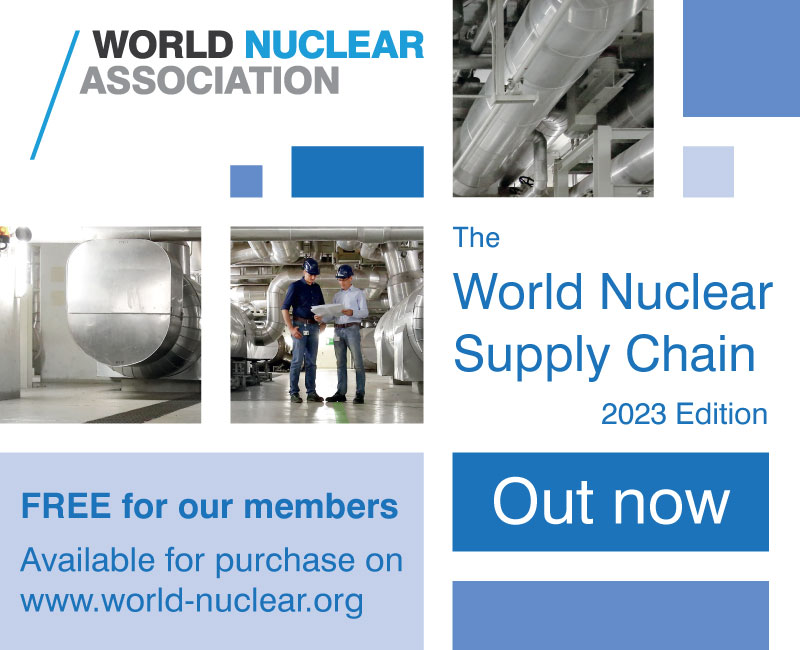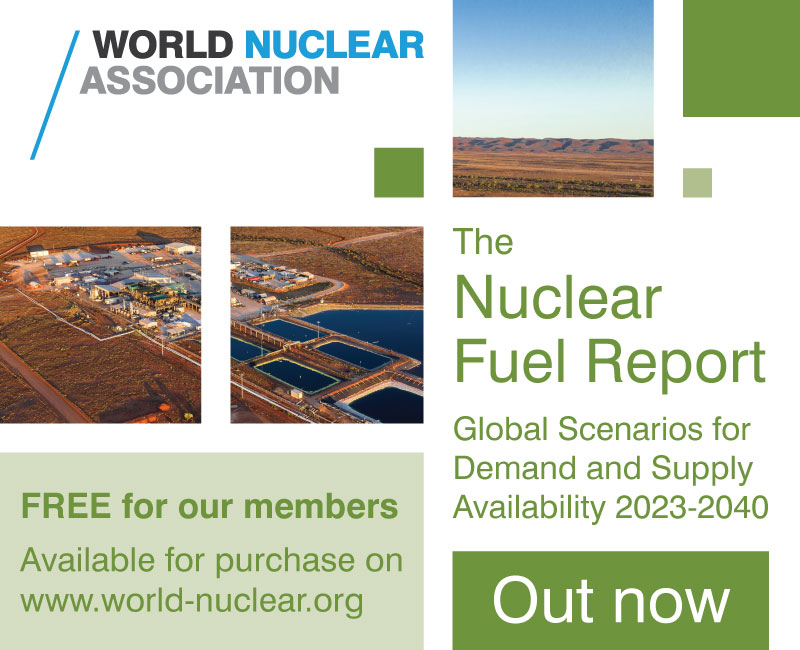NuScale highlights multiple applications of SMRs
.jpg)
NuScale has conducted studies into the use of its SMR design for flexible power operations, hydrogen production, process heat and power for oil refineries, and water desalination. Its technology is so far the first and only SMR undergoing the US regulatory process. Reyes provided the conference with a paper summarising the results of these studies.
"In order to have flexible facilities, you need to have a flexible control room and small modular reactors allow you to have multiple applications in one plant, which would be much more difficult to achieve with a large reactor," Reyes said. "Six operators can very safely and efficiently control all 12 reactors, but we’ve also built in automation for flexible operation."
As the penetration of renewable energy increases, the need for systems that can balance and stabilise the grid using carbon-fee power will become increasingly important as reflected in the Energy Imbalance Markets (EIM) emerging in the USA, he said.
NuScale has also studied the potential for hydrogen production for fuel cell vehicles and other industrial applications. One 60 MWe NuScale Power Module (NPM) could power about 70,000 fuel cell vehicles, he said. Similarly, coupling of a NuScale plant to a 250,000 barrel per day oil refinery could bring a 40% reduction in CO2 emissions, he added.
Energy Imbalance Markets
An EIM is a voluntary market that provides a sub-hourly economic dispatch of participating resources for balancing supply and demand every five minutes. An energy optimised IES that incorporates a flexible power SMR can assure full utilisation of the SMR power output, while providing economic carbon-free electrical and thermal power to industrial processes, Reyes said. Working within an EIM, it can also serve to balance and stabilise the grid.
The economic value of flexible nuclear power operation is likely to increase with the growth in penetration of renewable energy sources.
"EIMs are currently forming in the United States to balance supply and demand in grids with significant variable power generation … EIMs that include nuclear power load following plants may offer a premium for carbon-free power when wind and solar are not available or to stabilise the grid," he said.
"By their nature, Energy Imbalance Markets indirectly encourage the development of nuclear powered IES. If flexible power SMRs are providing power to an EIM primarily when renewables are not available, or to perform frequency hunting to keep the grid stable, what should their role be during their ‘reduced power hours’? An energy-optimised IES that incorporates a flexible power SMR offers an interesting solution. It can assure economic and full utilisation of the SMR power output, while providing carbon-free electrical and thermal power to industrial processes. It has the potential to address humanitarian needs like increased availability of clean water and reduce carbon emissions in the transportation and industrial sectors," he said.
Operational flexibility
Efficient use of an SMR-based IES will require some level of operational flexibility, particularly in remote locations where the SMR is the only source of power generation for both industrial and residential customers. The design of a NuScale plant, which comprises up to 12 NPMs, offers “significant operational flexibility” for IES applications, he said.
Each NPM can bypass 100% of its steam output to its condenser or to an industrial process, such as hydrogen production or industrial heat. By adjusting the valve position on the steam turbine, the NPM electrical power output can increase from 12 MWe (20%) to 60 MWe (100%) in 27 minutes or reduce power from 100% to 20% in 10 minutes, he said. In this mode, the thermal power of the NPM - 200 MWt - remains constant, which permits the transition from electric power production to thermal power production for industrial processes.
This feature also allows for rapid load following, he said, which may be required to offset the variability of output from wind farms, for example.
"The NPM also has significant thermal power manoeuvrability through the motion of control rods. NPM thermal power can increase from 20% to 100% in 96 minutes by control rod motion. This is adequate for load following solar farms and industrial processes that vary slowly over hours to days," he said.
Hydrogen production
Given the currently low cost of natural gas in the USA, he said, steam-methane reforming is the most common method there of producing hydrogen.
"It requires combustion of roughly 10-15% of the methane in the feed stream to generate the heat and steam necessary to split the remainder of the methane; consequently, the resulting emission of CO2 is a concern," he said. "Alternatively, electrolysis can dissociate water or steam into a clean source of hydrogen and oxygen."
High-temperature steam electrolysis (HTSE) is an emerging technology, he said, and is about 40% more efficient than conventional water electrolysis. NuScale worked together with researchers at the Idaho National Laboratory (INL) to study the technical and economic feasibility of producing hydrogen using the HTSE process coupled to a six-module NuScale plant.
"Based on the analysis performed by INL, it was determined that a six-module NuScale plant implementing 50 MW modules would produce approximately 190 metric tons of hydrogen and 1500 metric tons of oxygen per day," he said. "Of significant interest was the result that only 1.15 MW, or only 2.4% of the total power output, was required to raise the steam outlet temperature from 300 degrees Celsius to 800 degrees at the mass flow rates required for the HTSE process. With regard to impact on the transportation sector, a single 60 MW module - NPM updated power rating - could produce enough hydrogen to power roughly 70,000 fuel cell vehicles."
Oil refineries
NuScale Power and Fluor Corporation conducted a preliminary technical and economic assessment to evaluate the feasibility of using NPMs to support oil recovery and refining processes, reducing the overall carbon footprint of these industrial complexes and preserving fossil resources as feedstock for higher value products. Their assessment considered a representative refinery sized to process 250,000 barrels/day of crude oil.
"The cost differential between using nuclear-generated electricity and heat relative to the reference scenario of using natural gas was calculated for a variety of natural gas prices and potential CO2 tax penalties," Reyes said. Based only on operating costs, the 10-module NuScale plant is competitive with the reference case for natural gas prices as low as USD5/MBtu, he said, "even with no CO2 tax".
The capital investment for the NuScale plant can be recovered in 25 years if the natural gas cost exceeds USD9.5/MBtu without a carbon tax, or USD7.5/MBtu with a USD40/Mt CO2 penalty, he said.
"While such gas prices exceed current prices in the US, they are well below prices in many other countries," he said. By providing both process steam heat and electrical power, a 10-module NuScale plant would reduce CO2 emissions from the refinery by about 40% or roughly 200 Mt/hr, he added.
Progress
NuScale is about USD900 million into the development of its SMR design, Reyes told delegates, and has its first customer - Utah Associated Municipal Power Systems, which services six western states of the USA.
"I started the company with three patents. We now have 485 patents either granted or pending and in 20 countries. We are a triple bottom-line company - people, planet and prosperity and this resonates with all of our employees. Our mission is to provide advanced scalable nuclear power for the production of electricity, but also to provide clean water and heat with the goal of improving the quality of life for people around the world."
Unlike a conventional large-scale nuclear power unit, the SMR design involves building both the reactor vessel and the containment in a factory to then be shipped in three parts to the site by truck, rail or barge. It is then installed in a common pool of water, which resides underground in a seismic category 1 building.
"The advancement is that while you're doing your civil construction on site, in parallel you’re doing your nuclear fabrication. As a result, the construction time drops from about five years to approximately three years and that’s for the first-of-a-kind plant," he said.
The US Nuclear Regulatory Commission is expected to complete its design certification review of NuScale’s SMR by September of next year.
_92619.jpg)

_84504.jpg)










